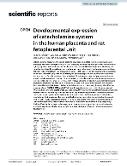Developmental expression of catecholamine system in the human placenta and rat fetoplacental unit

Autor
Karahoda, Rona
Váchalová, Veronika
Portillo, Ramón
Datum vydání
2024Publikováno v
Scientific ReportsRočník / Číslo vydání
14 (1)ISBN / ISSN
ISSN: 2045-2322Informace o financování
MSM//LX22NPO5107
MSM//SVV260663
UK/COOP/COOP
GA0/GA/GA20-13017S
Metadata
Zobrazit celý záznamTato publikace má vydavatelskou verzi s DOI 10.1038/s41598-024-57481-5
Abstrakt
Catecholamines norepinephrine and dopamine have been implicated in numerous physiological processes within the central nervous system. Emerging evidence has highlighted the importance of tightly regulated monoamine levels for placental functions and fetal development. However, the complexities of synthesis, release, and regulation of catecholamines in the fetoplacental unit have not been fully unraveled. In this study, we investigated the expression of enzymes and transporters involved in synthesis, degradation, and transport of norepinephrine and dopamine in the human placenta and rat fetoplacental unit. Quantitative PCR and Western blot analyses were performed in early-to-late gestation in humans (first trimester vs. term placenta) and mid-to-late gestation in rats (placenta and fetal brain, intestines, liver, lungs, and heart). In addition, we analyzed the gene expression patterns in isolated primary trophoblast cells from the human placenta and placenta-derived cell lines (HRP-1, BeWo, JEG-3). In both human and rat placentas, the study identifies the presence of only PNMT, COMT, and NET at the mRNA and protein levels, with the expression of PNMT and NET showing gestational age dependency. On the other hand, rat fetal tissues consistently express the catecholamine pathway genes, revealing distinct developmental expression patterns. Lastly, we report significant transcriptional profile variations in different placental cell models, emphasizing the importance of careful model selection for catecholamine metabolism/transport studies. Collectively, integrating findings from humans and rats enhances our understanding of the dynamic regulatory mechanisms that underlie catecholamine dynamics during pregnancy. We identified similar patterns in both species across gestation, suggesting conserved molecular mechanisms and potentially shedding light on shared biological processes influencing placental development.
Klíčová slova
Placenta, Monoamines, Trophoblast, Metabolism, In vitro models
Trvalý odkaz
https://hdl.handle.net/20.500.14178/2729Licence
Licence pro užití plného textu výsledku: Creative Commons Uveďte původ 4.0 International







